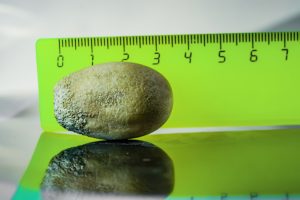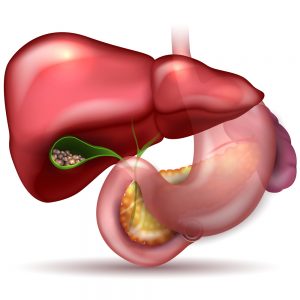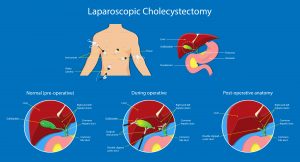

The gallbladder is an organ and sits below the liver in the upper right side of your abdomen (belly). The gallbladder functions normally to store bile (a green-yellow fluid) that is squeezed into your bowel after eating in order to help digest food containing fats/oils. Gallstones can form within the gallbladder, which can cause gallbladder pain (usually in the upper abdomen or right side of the trunk) if the gallbladder squeezes against the stones. They can also block the gallbladder and create an infection which may become serious. If they pass out of your gallbladder, they can cause serious problems such as pancreatitis, jaundice, or cholangitis (bile duct infection). In many cases, gallstone surgery is recommended to alleviate these issues and prevent further complications.


FAQs
Do I need to have my gallstones removed?
This depends mostly on if they have or are causing you problems. It also depends on your other general health conditions you may also have. Pain is the most common symptom and this could be caused by the gallbladder ‘squeezing’ on the stone/s, an infection caused by the stones, passing the stone past the pancreas causing pancreatitis or jaundice and infection (cholangitis).


Due to x-rays and ultrasounds being undertaken readily and frequently now for many different reasons, ‘asymptomatic’ gallstones can be picked up on such scans. Around 25% of people over 50yrs old may have gallstones and not be aware of this. Most of these patients do not need their gallbladders removed. Gallstone Surgery would be recommended for some of these people. Sometimes the signs of problems caused by the gallstones can be subtle, and it is always important to exclude other complications or problems with the gallbladder.
Are Gallstones common?
Yes. Gallstones are a common problem in our society. Around 25% of people over 50yrs old may have gallstones and not be aware of this. It is thought gallstones are common in our society due to our diet and lifestyles
What does the Gall Bladder do?
The gallbladder is an organ and sits below the liver in the upper right side of your abdomen (belly). The gallbladder functions normally to store bile (a green yellow fluid) that is squeezed into your bowel after eating in order to help digest food containing fats / oils. Gallstones can form within the gallbladder, which can cause pain (usually in the upper abdomen or right side of the trunk) if the gall bladder squeezes against the stones. They can also block the gallbladder and create an infection which may become serious. If they pass out of your gallbladder they can cause serious problems of pancreatitis, jaundice or cholangitis (bile duct infection). Sometimes a person does not have gallstones as such, but ‘sludge’ in the gallbladder (like mud or sand) or polyps which can also cause the problems that gallstones do. These problems are identified by undergoing an ultrasound scan.



Gallstone Surgery is the mainstay of treating gallstones, and involves a keyhole operation and an overnight stay to remove the gallbladder. If stones have passed out of your gallbladder and become stuck in your bile duct, a highly specialised 3 mm telescope (choledochoscope) can be passed by a specialist Gallstone surgeon trained in this field.
Do I need my gallbladder?
The gallbladder is not an essential organ. As seen in the images, the gallbladder ‘hangs’ off the side of the bile duct which passes all the way from the liver to the bowel. The gallbladder is like a reservoir to store bile, a bit like a dam is a reservoir to a town water supply. When you eat foods containing fats/oils a signal is sent to the gallbladder to contract and so eject more bile to flow to the bowel to help digest the fats and oils in food. When you are not eating bile refills your gallbladder with only a trickle of bile passing down the bile duct to your bowel.



Removing your gallbladder means bile only flows down from your liver to the bowel down the bile duct. This still allows bile to act as it does, to help break down oils and fats in food. Most people notice no difference in their digestion or bowel habits. Sometimes people experience short term effects but almost all resolve so it is expected you will lead a completely normal life after this gallbladder surgery.
What does Surgery involve?
You are admitted on the day of Gallstone surgery and undergo a general anaesthetic. 4 tiny keyholes (1 hidden in the belly button) allow specialised surgery instruments to undertake the Gallstone surgery. Gas is passed into your abdomen (removed at the end of the operation) to allow the gallbladder and anatomy to be seen on a TV monitor.


Your surgeon uses the instruments to carefully dissect the gallbladder off the liver. An x-ray is usually then performed (called a cholangiogram) to check if any stones have passed into the bile duct (If this has happened an expert Gallstones surgeon in your field can remove this at the time). The gallbladder (with stones) is then removed via one of the keyholes. The gas is then removed and around 4-5 absorbable stitches are used to close the keyholes. You usually stay overnight in hospital but are walking and eating the same day as Gallstone surgery. The dressings normally stay for 1-2 weeks and then a clinic review is done by your surgeon. You can freely walk when you get home with the help of oral pain killers which may be needed for a few days usually.
Are there any other options than surgery?
When stones are causing symptoms or problems for you it is usually best to remove the stones and gallbladder. Gallstone removal Surgery has been the standard treatment for many decades and remains so. Sometimes it is best not to undertake surgery. If stones are not causing problems then no treatment is often best.
If a severe infection occurs in the gallbladder due to stones, and the risks of general surgery are high (for example elderly patient with severe other medical problems), sometimes a drain is placed in the gallbladder by xray guidance as an alternative.
If a stone passes down the bile duct and becomes lodged next to the pancreas or causes jaundice, often an ERCP (Endoscopic Retrograde Cholangiopancreatography) is performed which is done by an endoscopy passed through the mouth under anaesthetic. This does not however deal with stones that remain in the gallbl
Medications have been used in the past to help dissolve the stones but are not used commonly now as they tend to be ineffective
Can I just have the stones removed but keep my gallbladder?
In a situation where a gallstone has passed from your gallbladder down the bile duct (causing jaundice or pancreatitis) then an ERCP (Endoscopic Retrograde Cholangiopancreatography) can be performed which is done by an endoscope passed through the mouth under anaesthetic. This can remove the stone in the bile duct but it does not deal with stones that remain in the gallbladder.


For stones in the gallbladder itself, it is not standard to undertake surgery to open the gallbladder and just remove the stone/s. Invariably more stones are present which are not identified or recur later. Leakage can also occur from an opened gallbladder. Occasionally, where a nasty infection has caused a dense area of scar tissue on the gallbladder, it may be safest to remove the majority of the gallbladder and aim to remove all stones (to avoid complications of injuring the bile duct due to the scar tissue). This again, however is not the preferred approach but is only done if absolutely necessary.


What should I do now?
It is best to talk to your GP who can refer you to a specialist. Dr Phil Le Page, a renowned gallstones surgeon, has extensive experience in gallbladder removal and gallstone surgery. You can choose a specialist in consultation with your GP and book an appointment with Dr Le Page for a comprehensive evaluation.


